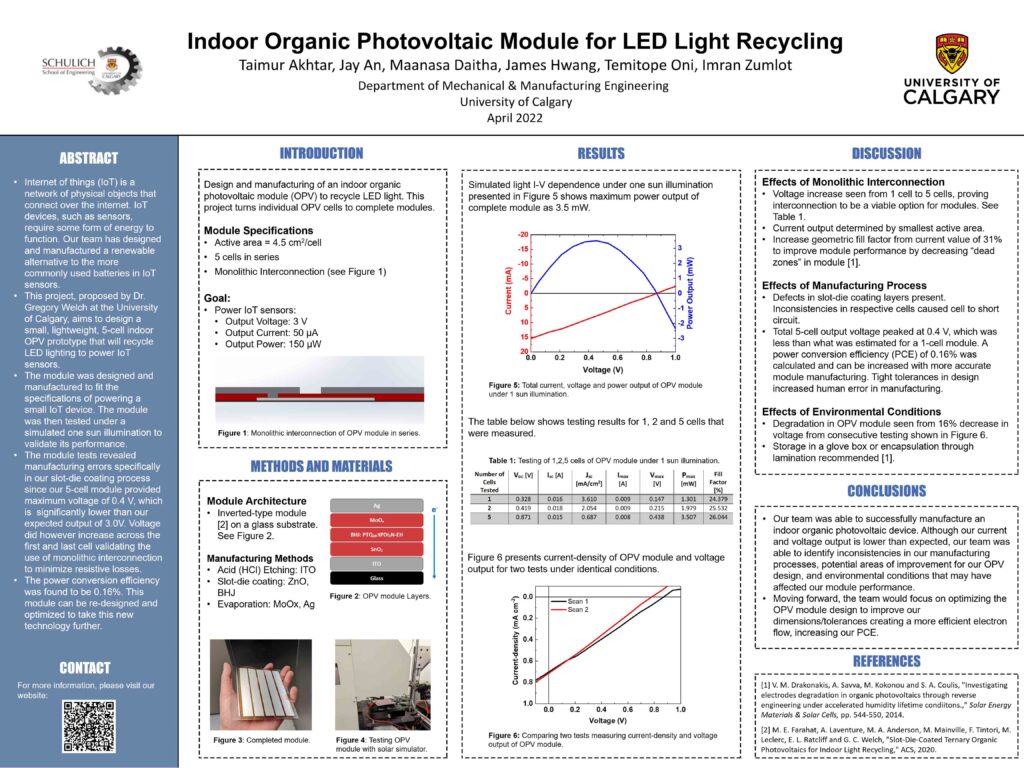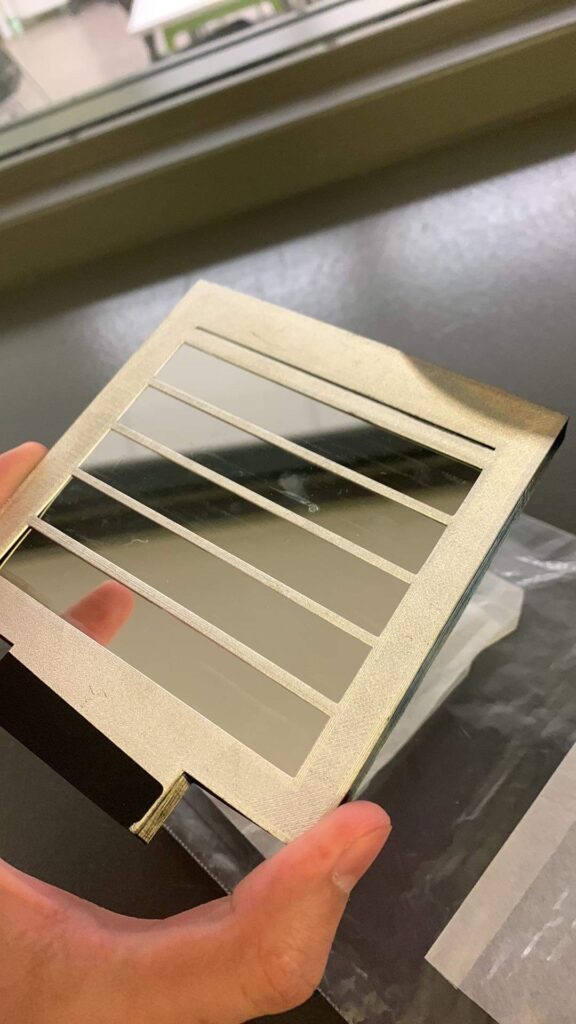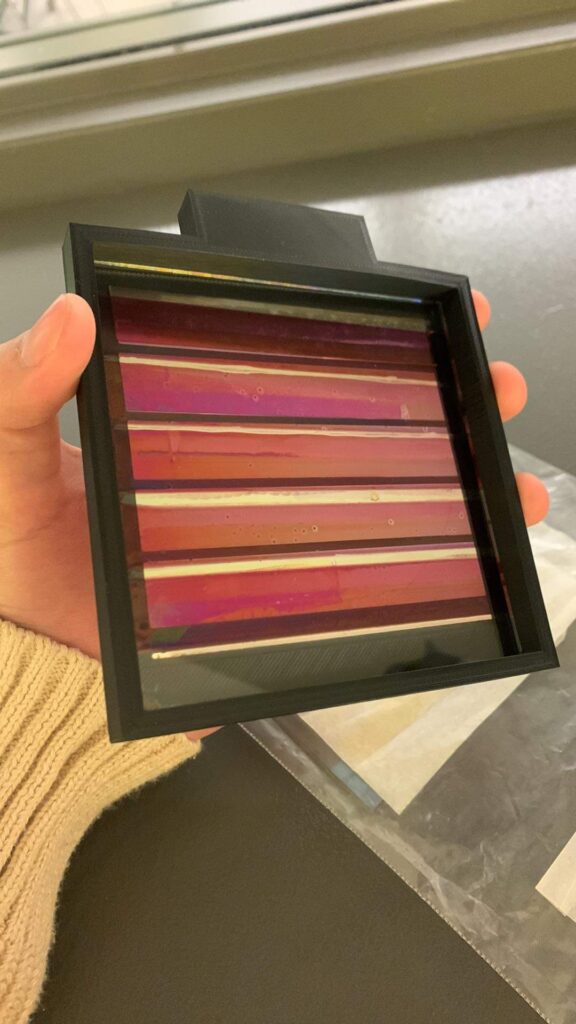Project Category: Mechanical
About our Project
Internet of things (IoT) is the network of physical objects that connect the world we live in today and are used for various purposes. These components, such as sensors, require energy to work. In a world where the push for renewable energy is more prominent than ever, facilitating a low cost and easy to procure solution is necessary. Often, the cost of the changing the batteries in these IoT sensors is greater than the cost of the sensors themselves. Indoor organic photovoltaic (OPV) modules are a viable solution to this very problem. By harvesting energy in low light, indoor environments, we can produce energy from a resource abundant in our day-to-day lives: LED lights.
Organic photovoltaic cell modules will be small, thin, flexible, and more importantly a practical solution to a problem we face in today’s market. This project is partnered with Welch Research group who provided the active coating materials used in our OPV module design.

Details about our design
HOW OUR DESIGN ADDRESSES PRACTICAL ISSUES
Solar power isn’t perfect. When we think of solar panels, we think of “sustainability”, and “renewable energy”. There are 3 main problems with solar power:
- Energy Demand – manufacturing solar panels require more energy and fossil-fuel burning equipment than they save by using solar energy.
- Chemicals – toxic chemicals are used to make silicon solar cells, and these may or may not be disposed of properly.
- Recycling – once the lifetime of a solar panel is reached, it is disposed of with other standard waste. It is not properly recycled, or able to biodegrade, leading us back to unsustainable resources.
This new technology of photovoltaics with organic active materials solves these problems.
As well, IoT sensors have become increasingly popular especially with the COVID-19 pandemic in 2020. There are expected to be 64 billion IoT devices worldwide by 2025. Assuming they are battery powered and each battery lasted for a decade without needing replacement, a technician would still need to be changing millions of batteries daily to sustain the use of these sensors. This is tedious labour and is cost prohibitive. To overcome this problem, OPVs will be used to harvest energy from its surroundings and power the sensors.
Our OPV design is cost effective and will be the new, clean face of photovoltaics.
WHAT MAKES OUR DESIGN INNOVATIVE
Various Applications: Our design can be manipulated based on the required power output for the application the module will be used for. The applications of OPV’s are endless. Although our goal is to power an IoT sensor using LED lights, OPVs can be used to power up any devices that require electricity. Our module can be printed onto polyethylene for example, and be made for a flexible application like wearable technology on athletes. OPVs can be mass produced to reduce the cost of manufacture and produce electricity from anywhere around the world.
Biodegradable: The active layers of our module are completely organic and biodegradable – unlike silicon photovoltaics (commercial solar panels), that dominate the market currently. This technology is unique, and is a pure renewable energy source.
WHAT MAKES OUR DESIGN SOLUTION EFFECTIVE
Our biggest goal was to design an organic photovoltaic module using monolithic connections between the layers. Our team achieved this by manufacturing the first OPV module ever created in Alberta and possibly in Canada. Although the module electrical output is below the required power of an IoT sensor, this project acts as a proof of concept and allows us to identify areas for improvement and optimization. For example, we learned that slot-die coating of each strip of the active area would increase the chances of short circuiting the module. To improve on this, the slot-die coating of the active area would be done all at once and laser scribe would be used to remove the unwanted parts resulting in even layers.
HOW WE VALIDATED OUR DESIGN SOLUTION
Our design is the end product from the numerous information obtained from several research papers and reverse engineering commercial OPV modules. We tested our working prototype using a solar simulator that provided 1 sun illumination (1000 W/m2) onto the device. We measured the device by varying the voltage applied between two electrodes of the cells we were measuring. At each voltage applied, a corresponding current photogenerated in the active area by the solar simulator was measured.
A maximum output power of 3.5 mW was seen, giving a power conversion efficiency (PCE) of 0.16%.
FEASIBILITY OF OUR DESIGN SOLUTION
The design is feasible as the cost of producing the prototype is $57.41 per unit. When mass producing, this cost can be minimized even further. Buying materials in bulk, as well as minimizing operating costs by using more efficient CNC machines (rather than manufacturing by hand) can make our design even more feasible.
Partners and mentors
We want to thank the many people who helped us with this project. This would not be possible without the participation and the assistance provided by Dr. Jeff Pieper, Dr. Gregory Welch and members of the Welch Research Group: Dr. Rahim Munir, Dr. Anderson Hoff, and Dr. Pandeng Li. We appreciate all the assistance and time they provided to help us create, manufacture, and validate our OPV module.
Our photo gallery








References
[1] M. E. Farahat, A. Laventure, M. A. Anderson, M. Mainville, F. Tintori, M.Leclerc, E. L. Ratcliff and G. C. Welch, “Slot-Die-Coated Ternary Organic Photovoltaics for Indoor Light Recycling,” ACS, 2020.






